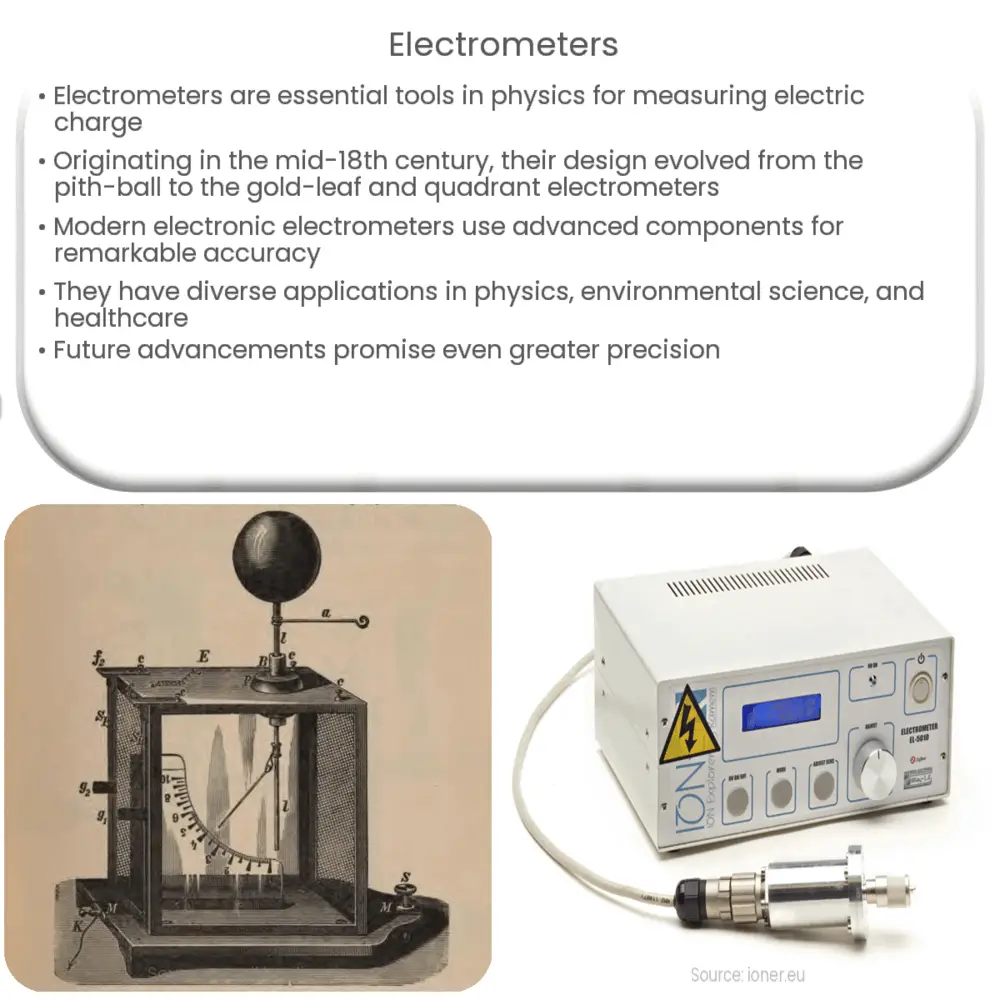Explore the history and functionality of electrometers, from their inception to modern versions, and their diverse applications across industries.

Introduction to Electrometers
An electrometer is an essential tool in the realm of physics, specifically in the study of electricity. Its primary function is to measure electric charge or electrical potential difference. There are several types of electrometers including the gold-leaf electrometer, the quadrant electrometer, and modern electronic electrometers.
Historical Background
The history of electrometers traces back to the mid-18th century. The first electrometer, known as the pith-ball electrometer, was invented by John Canton in 1754. This early design, while crude by modern standards, established the groundwork for future electrometer development. The first truly precise and reliable electrometer, the gold-leaf electrometer, was introduced by Abraham Bennet in the late 18th century.
The Gold-Leaf Electrometer
- Design and Function: The gold-leaf electrometer employs a thin piece of gold leaf which can be deflected by electrostatic forces. This device is sensitive to charge and can provide a visual indication of the presence of an electric charge, but it does not give a numerical reading of its magnitude.
- Limitations: Although useful, the gold-leaf electrometer has its limitations. Its lack of quantitative measurement capability and its vulnerability to environmental factors like temperature and humidity changes curtail its use in more sophisticated applications.
The Quadrant Electrometer
- Advancements: The quadrant electrometer was a significant advancement over the gold-leaf design. Invented by Lord Kelvin in the 19th century, it provided a much more sensitive and precise means of measuring electric potential.
- Function: This device operates on the principle of electrostatic attraction and repulsion. A lightweight aluminum vane is suspended within a quadrant-shaped box, and when an electric potential is applied to the quadrants, the vane moves. This movement can then be read off a scale to give a measure of the potential applied.
Modern Electronic Electrometers
Modern electronic electrometers represent the zenith of the technology’s evolution. They use highly advanced, sensitive electronic components to measure electric charge and potential with remarkable accuracy. Some electrometers today are even capable of measuring charges as small as a few femtocoulombs (10-15 coulombs).
The Working Principle of Modern Electrometers
Modern electrometers use the principle of the field-effect transistor (FET), which acts as a voltage amplifier. These electrometers can measure both very high resistance and very small charge movements accurately. A key part of the modern electrometer is the input stage, which often utilizes a special type of FET known as a “voltage follower”. This helps maintain a very high input impedance, enabling the electrometer to make measurements without significantly disturbing the system it is measuring.
Applications of Electrometers
- Physics and Engineering: Electrometers are widely used in various areas of physics and engineering. They’re invaluable for detecting and measuring electrostatic charges, verifying theories, and even exploring the nature of particles and forces in the universe.
- Environmental Science: In environmental science, electrometers are used to measure atmospheric electricity and study atmospheric ions and radioactivity.
- Healthcare: In healthcare, electrometers are used in radiation therapy to ensure accurate doses of radiation are delivered to patients. They are also used in diagnostic equipment such as PET scanners.
Future Perspectives
As the field of electronics continues to advance, so too does electrometer technology. Future electrometers will likely be even more sensitive and precise, enabling researchers to make ever more refined measurements. They may also become more portable and accessible, expanding their potential uses and applications.
Conclusion
In conclusion, electrometers play a pivotal role in a wide array of fields, from physics and engineering to environmental science and healthcare. From the initial design of the pith-ball electrometer to today’s advanced electronic models, they have proved to be an essential tool for measuring electric charge and potential. With ongoing advancements in technology, electrometers will continue to evolve, potentially offering even greater precision and a wider range of applications. Their importance in our understanding and application of electrical phenomena cannot be understated.

